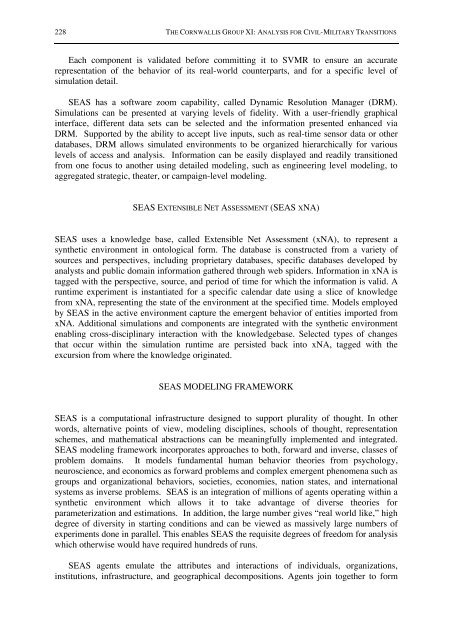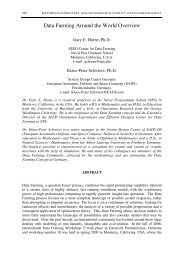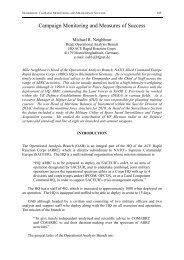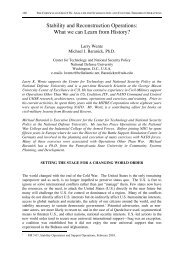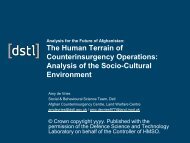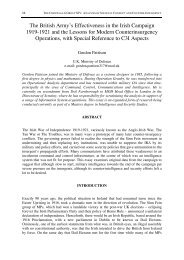228 THE CORNWALLIS GROUP XI: ANALYSIS FOR CIVIL-MILITARY TRANSITIONSEach component is validated before committing it to SVMR to ensure an accuraterepresentation of the behavior of its real-world counterparts, <strong>and</strong> for a specific level ofsimulation detail.SEAS has a software zoom capability, called Dynamic Resolution Manager (DRM).Simulations can be presented at varying levels of fidelity. With a user-friendly graphicalinterface, different data sets can be selected <strong>and</strong> the information presented enhanced viaDRM. Supported by the ability to accept live inputs, such as real-time sensor data or otherdatabases, DRM allows simulated environments to be organized hierarchically for variouslevels of access <strong>and</strong> analysis. Information can be easily displayed <strong>and</strong> readily transitionedfrom one focus to another using detailed modeling, such as engineering level modeling, toaggregated strategic, theater, or campaign-level modeling.SEAS EXTENSIBLE NET ASSESSMENT (SEAS XNA)SEAS uses a knowledge base, called Extensible Net Assessment (xNA), to represent asynthetic environment in ontological form. The database is constructed from a variety ofsources <strong>and</strong> perspectives, including proprietary databases, specific databases developed byanalysts <strong>and</strong> public domain information gathered through web spiders. Information in xNA istagged with the perspective, source, <strong>and</strong> period of time for which the information is valid. Aruntime experiment is instantiated for a specific calendar date using a slice of knowledgefrom xNA, representing the state of the environment at the specified time. Models employedby SEAS in the active environment capture the emergent behavior of entities imported fromxNA. Additional simulations <strong>and</strong> components are integrated with the synthetic environmentenabling cross-disciplinary interaction with the knowledgebase. Selected types of changesthat occur within the simulation runtime are persisted back into xNA, tagged with theexcursion from where the knowledge originated.SEAS MODELING FRAMEWORKSEAS is a computational infrastructure designed to support plurality of thought. In otherwords, alternative points of view, modeling disciplines, schools of thought, representationschemes, <strong>and</strong> mathematical abstractions can be meaningfully implemented <strong>and</strong> integrated.SEAS modeling framework incorporates approaches to both, forward <strong>and</strong> inverse, classes ofproblem domains. It models fundamental human behavior theories from psychology,neuroscience, <strong>and</strong> economics as forward problems <strong>and</strong> complex emergent phenomena such asgroups <strong>and</strong> organizational behaviors, societies, economies, nation states, <strong>and</strong> internationalsystems as inverse problems. SEAS is an integration of millions of agents operating within asynthetic environment which allows it to take advantage of diverse theories forparameterization <strong>and</strong> estimations. In addition, the large number gives “real world like,” highdegree of diversity in starting conditions <strong>and</strong> can be viewed as massively large numbers ofexperiments done in parallel. This enables SEAS the requisite degrees of freedom for analysiswhich otherwise would have required hundreds of runs.SEAS agents emulate the attributes <strong>and</strong> interactions of individuals, organizations,institutions, infrastructure, <strong>and</strong> geographical decompositions. Agents join together to form
CHATURVEDI ET AL.: MODELING STABILITY AND RECONSTRUCTION OPERATION USING SEAS 229networks from which evolve the various cultures of the world’s population. Intricaterelationships among political, military, economic, social, information <strong>and</strong> infrastructure(PmESII) factors emerge across diverse granularities. Statistics calculated from thesimulation are then used to provide measurable evaluations of strategies in support of aneffects-based approach to operations (EBAO) decision making.The fundamental agent categories in SEAS are the individuals, organizations, institutions,<strong>and</strong> infrastructure (IOIIG). The population agents of these fundamental types form higherorder constructs in a fractal-like manner where sufficient detail exists at multiple levels offocus, from world constructs to individuals. Higher order constructs include political systems(type of government, political parties/factions), militaries (soldiers, institutions, branches ofservice), economic systems (formal banking networks <strong>and</strong> black-market structures), socialsystems (tribes, religious groups, neighborhoods) <strong>and</strong> information systems (print, broadcast,internet).Agents representing individuals are used to model the populace in the syntheticenvironment. Individual agents are categorized into citizen <strong>and</strong> leader agents. An individual’swell being is based on a model consisting of eight fundamental needs: basic, political,financial, security, religious, educational, health, <strong>and</strong> freedom of movement. The desire <strong>and</strong>perceived level of each of the well being categories are populated taking into account thesocio-economic class of the individual the agent represents.Citizen agents are constructed as a proportional representation of the societal makeup of areal nation. A citizen agent consists of a set of fundamental constructs: traits, well being,sensors, goals, <strong>and</strong> actions. The traits of citizen agents, such as race, ethnicity, income,education, religion, gender, <strong>and</strong> nationalism, are configured according to statistics gatheredfrom real world studies. Dynamic traits, such as religious <strong>and</strong> political orientations, emotionalarousal, location, health, <strong>and</strong> well being, result during simulation according to models thatoperate on the citizen agents <strong>and</strong> interactions they have with other agents. The traits <strong>and</strong> wellbeing determine the goals of a citizen agent. Each citizen agent “senses” its environment,taking into account messages from leaders the citizen has built a relationship with, media thecitizen subscribes to, <strong>and</strong> other members in the citizen’s social network. Each citizen agent’sstate <strong>and</strong> goals can change as a result of interactions the citizen has with its environment. Acitizen agent can react to its environment by autonomously choosing from its repertoire ofactions. Additionally, a citizen agent’s set of possible actions can change during the course ofthe simulation, such as when a citizen agent resorts to violence. Traits, well-being, sensors,<strong>and</strong> actions together determine the behavior of the citizen agent.Leader agents have additional traits over citizen agents <strong>and</strong> can have an influence levelwithin their organizations <strong>and</strong> institutions. A leader agent can take specific stances on keyeconomic, political <strong>and</strong> social issues <strong>and</strong> can influence citizen agents to take on the leader’sattitudes, thereby altering the political <strong>and</strong> social climate in an attempt to promote theleader’s goals. A leader agent that leads a specific organization is also able to leverage itsorganization’s resources. On the other h<strong>and</strong>, citizen agents can elect leaders to places ofposition <strong>and</strong> replace former leaders.Clusters of citizen <strong>and</strong> leader agents form organizations. Citizen agents voluntarily joinorganizations due to affinity in perspective between the citizens <strong>and</strong> the organization. Anorganization agent’s behavior is based on a foundation consisting of the desires of theorganization’s leaders <strong>and</strong> members. Organizational leadership constantly seeks maintenance


